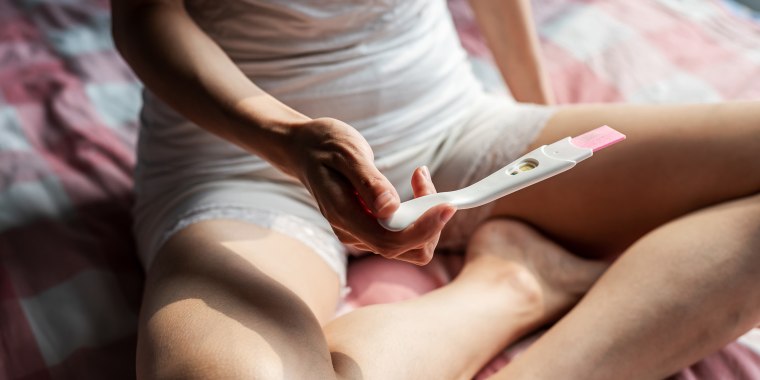Most women spend the majority of their reproductive years trying not to get pregnant. So it's no wonder that some couples, when they decide to have a child, realize they're not exactly sure what they need to do to make that happen.
Of course, the biggest and most important requirement should be obvious — having sex — but, as many people learn when they're trying to conceive, it's not always that simple. After all, there are usually only a few days a month that a woman can even get pregnant. And figuring out what those days are can be tricky.
Here's what you need to know about how to get pregnant.
When do I ovulate?
Ovulation is when an egg is released from a woman's ovary and sent to the fallopian tube. Typically, this happens once during a menstrual cycle. If there's sperm around, the egg can be fertilized and then, if all goes well, the fertilized egg will implant itself into the uterine wall. If there aren't any sperm in the tube, the egg moves along and eventually disintegrates.
If a couple is trying to conceive, sex should be timed around ovulation. But when does that happen? For most women, ovulation happens 14 days before your next period starts.
"The reason we say that as opposed to 'in the middle of your cycle' is that there is some variation in terms of cycle length," Dr. Lauren Streicher, an OB-GYN and medical director of the Northwestern Medicine Center for Sexual Health and Menopause in Chicago, told TODAY. "It seems to be a set time between ovulation and when you get your period."
So for a woman with a regular 28-day cycle, ovulation would occur around day 14. (Consider day 1 being the first day of the menstrual cycle.) For a woman who has a 32-day cycle, ovulation would happen around day 18. For women whose cycles vary, it can be harder to track ovulation. That's why ovulation tests might help.
What are ovulation tests?
These are relatively inexpensive tests women can do at home to help predict ovulation.
Here's how they work: Right before a woman ovulates, the pituitary gland releases a surge of luteinizing hormone (LH). Ovulation predictor kits measure the spike in LH, not ovulation itself. (It is possible to have the LH surge but not actually ovulate, but if you're having regular menstrual cycles, you're probably ovulating, according to Dr. Michael Edelstein, a fertility specialist with Shady Grove Fertility in Richmond, Virginia.)
Most of the kits come with multiple sticks or strips so that women can test their urine during multiple days in their cycle. After getting the LH surge, most women ovulate within a day.
"The kits are really terrific," said Dr. Mary Jane Minkin, an OB-GYN and clinical professor of obstetrics at Yale University in New Haven, Connecticut. "They're pretty darn accurate. You can actually say, we're going to be ovulating today, let's have sex."
Other ways to tell if you're ovulating
During their fertile window, many women will notice that their cervical mucus has a stretchy, egg-white consistency, which actually helps preserve sperm. This is a good indication that you should have sex soon. After ovulation, the amount of cervical mucus will begin to decline, according to the American Pregnancy Association.
Women can also chart their temperatures to track ovulation. By monitoring their basal body temperature throughout their cycles over a few months, a pattern may start to emerge. Women might notice a small spike in their temperature in the days immediately following ovulation, which can help them predict when they will ovulate in their next cycle.
The downside? Charting can be cumbersome, and because the temperature fluctuations are so minor, there's a lot of room for error, and so this method isn't "tremendously reliable," Minkin said.
When am I the most fertile?
The day a woman ovulates is not the only day she can get pregnant.
Most of the doctors TODAY spoke to said that the average fertility window in a single cycle is about three days, maybe up to five days in certain circumstances.
"We believe a woman is fertile probably a couple days before she ovulates and maybe a day or so after she ovulates," Edelstein said.
But keep in mind that sperm can live in the vagina for up to five days after sex.
"There are cases of sperm found five days later, but it's rare," Minkin said. "So if you had sex five days before ovulation, well, there might still be one sperm hanging around (when you ovulate). But as far as optimal timing goes, timing sex around ovulation is probably ideal."
What are my chances of getting pregnant during ovulation?
Even if a couple's timing is perfect, it's not a guarantee that pregnancy will happen right away. On average, about 15%-20% of couples get pregnant within one month of trying, Minkin said. That varies when age and other factors are taken into consideration, but it's a good rule of thumb to keep in mind. If you’re concerned about your fertility, talk to your OB-GYN about visiting a fertility specialist.
But don't get discouraged if it's not happening right away: For most couples, it doesn't. Just try again next month — and try to have fun along the way!
Related:




